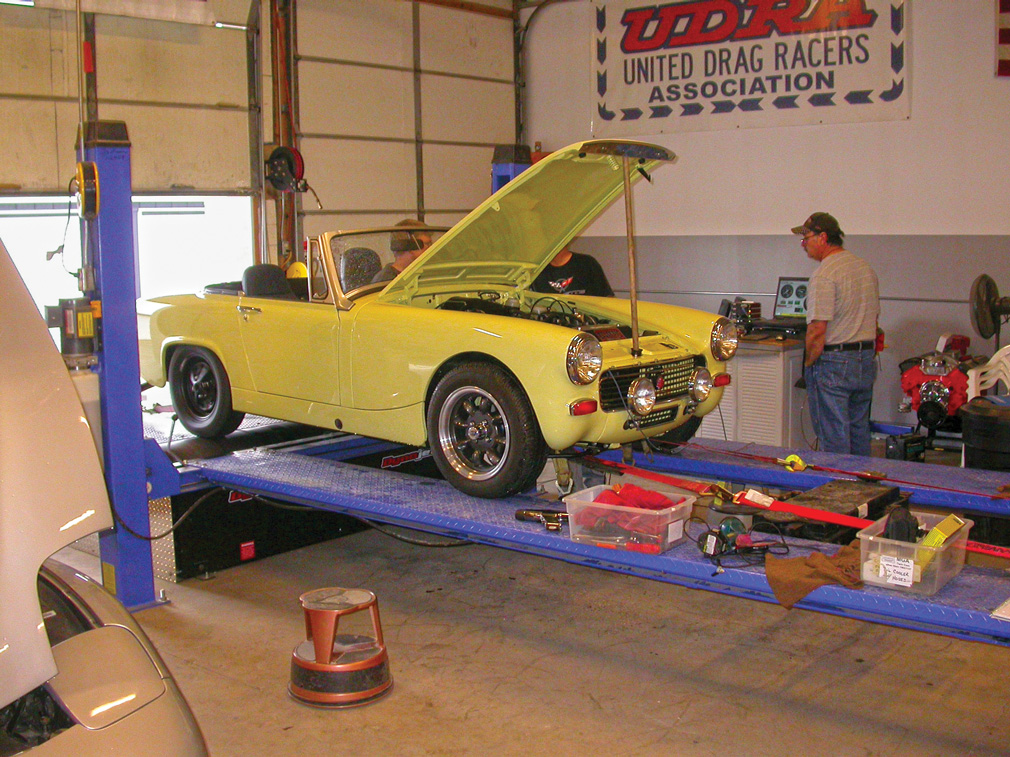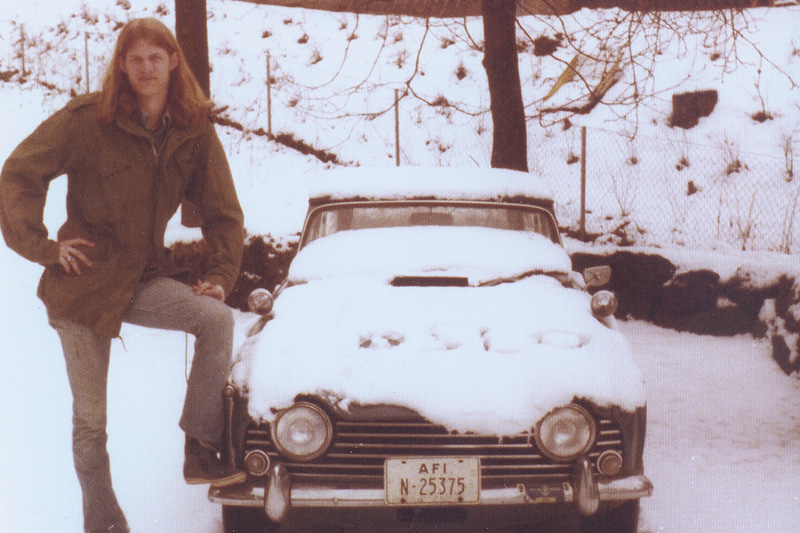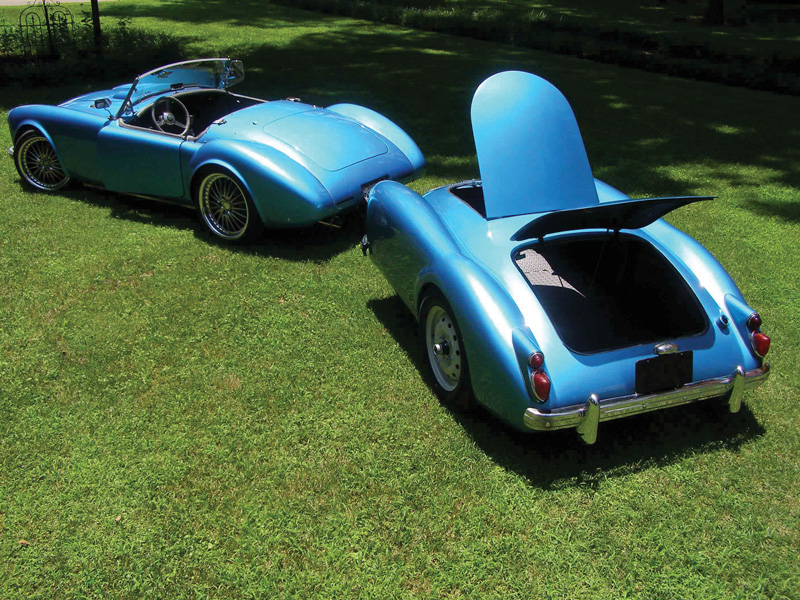Fall in Love With Dyno Tuning in 9 Easy Steps
Modern technology is changing how we interact with classic cars, and sometimes we can’t help but laugh. After all, these situations can get pretty anachronistic.
More and more, we rely on high-tech tools to keep our classics in tune. Static timing has been replaced by dynamic timing; reading spark plugs has been replaced by tailpipe sniffers; and the holy grail of tuning tools—the dynamometer—is generally within reach of any enthusiast.
While classic car owners and shops have quickly adopted most digital tools, the dynamometer still seems steeped in controversy and confusion. “Will it blow up my engine?” is a common question.
We’ve made thousands of dyno pulls, solving scores of problems and eking out lots of power along the way. We still haven’t blown up a single engine on the dyno. In fact, these sessions have saved many engines from an untimely demise by allowing us to catch and identify problems in a controlled environment.
1: No Fear
It’s human nature to fear what we don’t understand, and the dyno is no exception. Like most fears, however, this one can be erased by knowledge.
First off, there are two basic types of automotive dynamometer, the engine dyno and the chassis dyno. Think of it this way: the engine dyno tests engines that are removed from the car—the flywheel is bolted to the dyno—while the chassis dyno allows the engine to remain inside the car. With the chassis dyno, the car is strapped down so that the entire driveline spins the machine’s rollers.
There are also different dyno designs. Some use a water brake and a torque arm to measure torque. Others use an electric current (eddy current) to measure torque. Still others use math to calculate the acceleration of a known mass and derive horsepower and torque from there.
Once the torque at every single rpm point is recorded, the dyno’s computer can compute a corresponding horsepower figure. This info is displayed on a computer screen, and printouts are just a keystroke away.
While each design has its pluses and minuses, the chassis dyno has become much more common among the general population for the simple reason that the engine doesn’t have to be removed for testing. In fact, we have a bold statement about the subject: A chassis dyno session is one of the easiest and least expensive ways to put the finishing touches on a tune-up, solve a tricky drivability problem, or both.
2: A Chicken in Every Pot and a Chassis Dyno on Every Corner
While dial-back timing lights and wideband oxygen meters have been making their way into many people’s toolboxes, few of us have the space or cash to install a chassis dyno.
Maybe it’s a stretch to say that there’s a chassis dyno shop on every corner, but most people have one within an hour or two of home. Better yet, medium to large metropolitan areas tend to have multiple dyno shops.
How do you find one? Ask around. The local racers know whose shops are so equipped. Most of the dyno manufacturers also list their customers online. As far as cost, expect to pay about a hundred dollars for a baseline session.
3: Don’t Get Started With the Last Step
Once people overcome their fear of the dyno, they seem to experience another phenomenon: they want to jump on the dyno too soon. As much as we value our dyno sessions, we usually save them for last in the tuning and diagnostic process.

Dyno shops secure the car to the ground with the same tie-down straps used on trailers. Know where your car's mounting points are located, and don't forget that the exhaust will get hot and the drive wheels will be moving very fast. You don't want a strap melting or getting wrapped up on an axle during a run.
Okay, there’s one time when we break that rule. Sometimes we baseline a new project just to get a starting point, but we consider that a luxury and not a necessity.
4: Be Prepared
If the dyno is our final step, how do we get prepared? We start by making sure our engine and driveline are in good shape.
Our drive wheels are going to hit some fairly high speeds while on the dyno, so we want to inspect everything involved. Tires, brakes, suspension, U-joints and so on all need to be in good shape.
Next, we completely tune the engine. Finally, we make a plan for our trip to the dyno shop, and ready the tools and supplies that we’ll need to execute that plan.
5: Tune-Up Time
Now it’s time to tune our engine. First, we ensure that the engine’s internal components are in good shape and adjusted properly. We start with a compression and oil pressure check. Assuming these go well, we begin a full tune-up by retorquing the cylinder head—or heads—and doing a valve adjustment.
Then, if there are any emissions controls on the car, we simply check that they’re functioning properly. Most of our classics have little more than a PCV system and maybe some evaporative loss equipment. However, you should leave these pieces in place; they don’t harm drivability and will keep things less stinky.
Next, it’s the ignition system’s turn. The points, plug, wires, cap and rotor must all be in good shape and ready for action. If applicable, the dwell should be within spec.
Ignition timing is critical. Not only do we check the setting at idle and at about 4000 rpm, but we also ensure that the advance curve is correct for our engine. Once we’re sure the ignition system is up to snuff, we move on to the induction side. We find and fix any vacuum leaks, then make sure the carburetors are clean and not worn out. After that, we jump into jetting and other adjustments.
Around this point, we realize that a dyno is going to be really helpful. Think about this: when performing a textbook tune-up, you’re mainly adjusting the ignition and carburetors while the engine is idling. Since the car is stationary, revving the engine doesn’t really place it under any load.
Here’s the kicker: since you spend much more time driving than idling, wouldn’t it be great to be able to make adjustments under load? That’s where the dyno shines and really helps with carburetor setup. At this point, we just try to get things close. If the car is bone stock, that’s pretty easy: set it up with the stock parts.
Keep in mind that a lot of cars have received some questionable work thanks to previous caretakers. If you see a stock carb on there, don’t assume that the jetting is as delivered—check to make sure. If the car has been modified, it’s time to either make some good guesses or contact an expert for advice.
A good tune-up is always followed by a nice drive. We take the car out and put it through its paces. It should idle well, accelerate smoothly, and cruise steadily. If it doesn’t, we go back and recheck our tune until it does—nine times out of 10, we find we can solve any drivability problems before we go to the dyno.
Remember that the dyno session is usually reserved for fine-tuning, and that these drivability problems can almost always be resolved beforehand. You could even consider bringing in a pro for some help. If you absolutely cannot find the problems with conventional tuning, exercise your last resort and use the dyno as your diagnostic tool.
6: Plan the Trip
While quick lube joints don’t require appointments, we’ve yet to see dyno shops offer drop-in service. You’re going to need to schedule the dyno session. And while you’re thinking about future plans, why not come up with some dyno time goals?
We try to keep each dyno session pretty short, an hour or less. We usually have a couple objectives in mind, like maximizing the timing, setting the jetting, or testing a part or two.
If you intend to diagnose a drivability problem, set the jetting, and test seven or eight parts in a single session, you’re asking for trouble in our book. Keep things simple and you’ll get quick rewards. Make things complicated and you’ll come back frustrated.
Once we decide on our goals, we make sure that we have the tools and parts needed to do the work—we’re assuming that the shop will let us work on our own car, but it pays to confirm this beforehand. If we follow our tuning example, we bring the following tools: basic screwdrivers, wrenches, pliers, a dial-back timing light, and tools needed to change the carburetor needles or jets. We also bring some needles or jets that are both richer and leaner than those in our current setup. A set of plugs and plug wires will come in handy if something goes wrong along the way.
To be really prepared, we often rehearse the job before going to the dyno. This helps us make sure that we have all of the needed tools. Plus, it can highlight any minor inconveniences that may crop up, for example, do the new parts require a different screw or nut?
7: On the Rollers
Now that we’re tuned and prepared, it’s time to take that big trip on the rollers.
We usually arrive at the dyno shop about 15 minutes ahead of our appointment. We let someone on staff know that we’re there, then get our car and tools prepped for the session.
Once the operator is ready for us, we explain our plan for the day. If we’re fine-tuning the car, for example, we say that we want to dial in the timing and get the jetting right before heading home. The operator can usually then determine how many pulls we need. In this case, probably 10 to 15.
The operator then instructs us on how to get the car on the rollers. Some shops have in-ground rollers; others feature above-ground equipment that requires the car to be raised into position via a four-post lift. Either way, we do exactly as instructed—we may be told to drive onto the rollers ourselves, or the staff may do it for us. We also let the operator strap down the car without interference or suggestions, unless they ask, of course.
Next, the operator typically asks us to slowly run the car on the rollers to check the tie-down straps and blocks one last time. Assuming everything is secure, it’s time for some more connections.
At the very least, an inductive pickup goes on a plug wire to measure rpm. We always add a wideband oxygen pickup. If a car already has an oxygen sensor bung in its exhaust, that can be used. Otherwise, we stick a probe in the tailpipe or weld on a second bung beforehand.

Timing adjustments are a great way to find free horsepower. On the flip side of the coin, improper timing can hamper performance or even harm an engine.
The protocol usually goes like this, but make sure to always follow the operator’s instructions:

A healthy dyno curve is a beautiful thing. Armed with a baseline, you'll be able to judge the effectiveness of future modifications.
• Ease the car into first gear to get the rollers spinning.
• Carefully accelerate to the gear you’re going to use for the pulls, usually third.
• Drop down to your starting rpm, the point where you want to start collecting data.
• Upon getting the “go” signal from the operator, put the accelerator to the floor.
• Once you hit the target rpm—the place where you want to stop collecting data, usually at or near redline—let off on the accelerator and disengage the clutch. Some operators have you turn off the engine.
• Now let the dyno use its own brakes to slow down the drive wheels. Never use your car’s brakes while on the rollers; the dyno’s large mass can burn them up.
• Once the dyno has come to a stop, hop out and check the results on its monitor.
• Make plans and changes for the next pull and repeat until done.
While most of the available chassis dynos feature the traditional roller, there is one variety that works differently. The Dynapack chassis dynamometers forgo the rollers for devices that are bolted to the car’s hubs.
Whatever the dyno make and model, we usually start our procedure with two back-to-back baseline pulls to make sure that everything is running correctly. We also want to make sure that the car is running consistently. If the baselines don’t repeat, we may be in for trouble. Consistency is key when testing.
With our baselines established, we follow our planned course of action. In the case of our tune-up, we adjust the timing first. Generally we deviate a few degrees in either direction of the factory setting, looking for the sweet spot that gives us the best power. Once we’ve done that, we do the same thing with our jetting.
The dyno session really pays off when working with jetting: the decreased power and less-than-ideal air-fuel curves immediately show up on the dyno’s screen. Armed with that information and a little knowledge of our induction system, we can quickly adjust the jetting and get the power where it should be.
The fine-tuning can sometimes add another 5 or 10 percent more power to our tally. That can sometimes make a half-second difference in zero-to-60 times and a second or more at the track. When we test parts on the dyno, not only do we discover whether they’re working as promised, but we get the fine-tune optimized for them, too.
8: Cool, But Will I Blow Up My Engine?
Even though the dyno places the engine under load, odds are strong that nothing will break. If something does come apart, it probably would have eventually happened on the street or track.
Also, consider the alternative testing methods, like timed zero-to-60 runs. First, you have to find a safe, long straight, not a trivial task, especially if legality is a concern, too.
Then there’s the mechanical strain. When you dump the clutch, some components take quite a beating. The clutch probably has to slip a bit, while the gearbox, driveshaft and rear axle take quite a shock. The rear suspension probably winds up a bit, and the tires feel some pain. Every time you shift gears, these shocks are repeated. Not only is safety a pretty big concern with this type of testing, but it places a lot of strain on the whole car.
Now consider how the dyno does its job. The drivetrain is already in motion before the data collecting begins. Nothing is shocked or jolted from a standstill. The clutch isn’t hammered, and the tires don’t have to claw for traction. A dyno pull feels like a 10-second drive up a steep hill. How many times have you blown up your engine doing that?
The dyno run is more consistent, after all, your driving skills don’t come into play. It’s also more precise, as it can measure horsepower to the hundredth decimal point and correct for the day’s atmospheric conditions.
9: Try It, You’ll Like It
A dyno is one of those tools that opens up your eyes and changes the way you do things. It’s kind of like a timing light: once you learn how to use it, you’ll never do static ignition timing again. The dyno is just that useful.
In addition to optimizing your car, you’ll get the bragging rights that come with it—you’ll know exactly what kind of power the car is making and where. Information like that allows you to enjoy your classic just a little bit more. And that’s the point. Like we said, don’t fear the dyno.
By Carl Heideman • Photography by the author
This story originally appeared in Classic Motorsports magazine. To request a free copy of the latest issue, visit classicmotorsports.net. Carl Heideman, the author, regularly hosts Tuning for Speed seminars. Learn more at eclecticmotorworks.com.








'Don’t Fear the Dyno' has no comments
Be the first to comment this post!